Designing with the Natural System for Coastal Resiliency in the Great Lakes
In recent years, communities big and small along the Great Lakes have faced challenges, including high lake levels, increasingly frequent extreme storms, and extreme fluctuations of water levels that have caused erosion along shorelines composed of sensitive ecosystems such as sand beaches, dunes, bluffs, and gullies. Because these challenges significantly threaten the economic well-being of local communities, it is imperative that communities continue to implement innovative strategies to manage and adapt to these challenges.
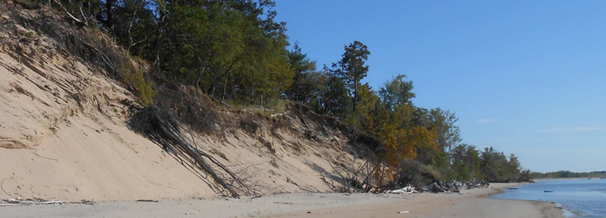
Shoreline erosion associated with high water levels and climate change in the Great Lakes Region has created risks to nearshore homes, businesses, roads, and parks.
Implementing Innovative Strategies to Enhance Resiliency: Designing with Nature
The ability of Great Lakes communities to bounce back from—rather than simply react to—hazardous events such as coastal storms, flooding, and extreme water levels is critical to achieving coastal resilience. A variety of environmental solutions and management approaches can be designed to protect coastal areas and ecosystems, enhance existing habitats, and make the Great Lakes coast more resilient in the long run. Several efforts that have already been implemented along Great Lakes shorelines can help us better understand how to sustain the health of coastal ecosystems for future coastal resiliency projects.
Working with Natural Systems to Create Resiliency: North Sandy Pond, Lake Ontario
North Sandy Pond is a large bay set off from Lake Ontario by barrier islands. The dune system in North Sandy Pond has long been integral to the environment, protecting shorelines and communities behind the pond. However, the barrier island was often breached during severe weather, with water breaking through the sand dunes and threatening the embayment habitat and infrastructure.
Anchor QEA was engaged to help restore North Sandy Point by dredging the navigation channel and restoring the natural barriers of the beach and dune system. We reused the dredged material to restore the dunes and replanted native vegetation, resulting in healthy vegetation stabilizing the beach and dunes and in optimal conditions for low- or high-water habitat. We also installed a barrier bar system to protect the town of Sandy Creek, placing dredged and washed-up debris such as tree trunks along the barrier bar to create habitat features and to re-establish the dunes. In many ways, this was a win-win situation: an optimal approach to coastal resilience that worked with the natural system while providing sustainable results for the long term.
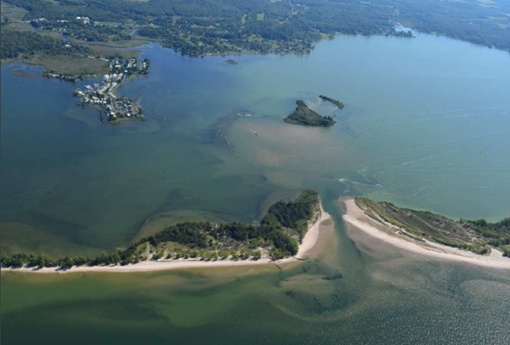
Restoring the North Sandy Pond beach and dune system included the placement of sand and vegetation to reduce breaching and prevent future erosion. Photography by G. Steadman and T. Hart.
Restoring Infrastructure to Prepare for the Future: Saint Lawrence River in the Great Lakes
When developing sustainable solutions, it is crucial to design and construct the appropriate preservation measures to protect from future erosive forces. A marina located along a beautiful river-walk in a village on the Saint Lawrence River had experienced severe dock damage and deterioration due to high water levels and wave energy, which were negatively affecting marina operations. Lacking the necessary features to function with resilience under these changing conditions, the marina could not operate at high and low tide.
Anchor QEA designed and constructed an offshore wave attenuation structure to protect the marina and dock from wave energy and other severe conditions. The structure constantly assesses how the wave conditions are changing so the marina and dock can adapt and prepare for these conditions. The result is improved marina operations and a safe and enjoyable experience for visitors to the Saint Lawrence River now and in the future.
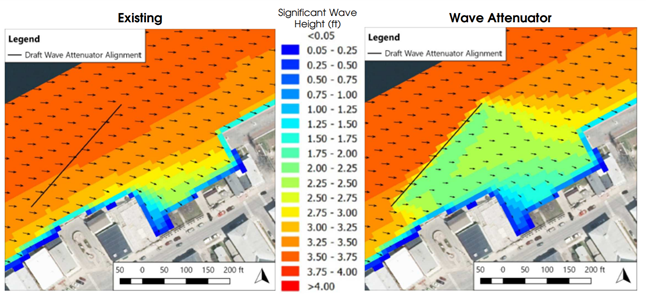
Anchor QEA’s model results that show the beneficial effects of the wave attenuation structure (image depicts colored flood maps that represent wave heights with and without the wave attenuation structure and its effect on wave climate along the marina and dock).
Exploring Methods to Mitigate Shoreline Erosion: Illinois Beach State Park Nearshore Reef
As part of the Great Lakes Health Port Futures Project, Anchor QEA is assisting in the evaluation of passive sediment management techniques to place dredged material, protect nearshore habitats, and reduce erosion in Illinois Beach State Park and along the Great Lakes. Passive sediment management is the use of natural forces—such as water, wind, and waves—to replace or augment one or more steps typically required in sediment management. Our team developed multidimensional wave models to estimate the effect of various nearshore structures on wind-generated waves and the nearshore sediment erosion, transport, and deposition they may cause.
The engineering evaluation included alternatives for passive sediment management. One alternative considered was low-crested offshore reef structures, which are rock structures piled on the lake bottom to reduce the long-term erosion of critical shoreline habitat.
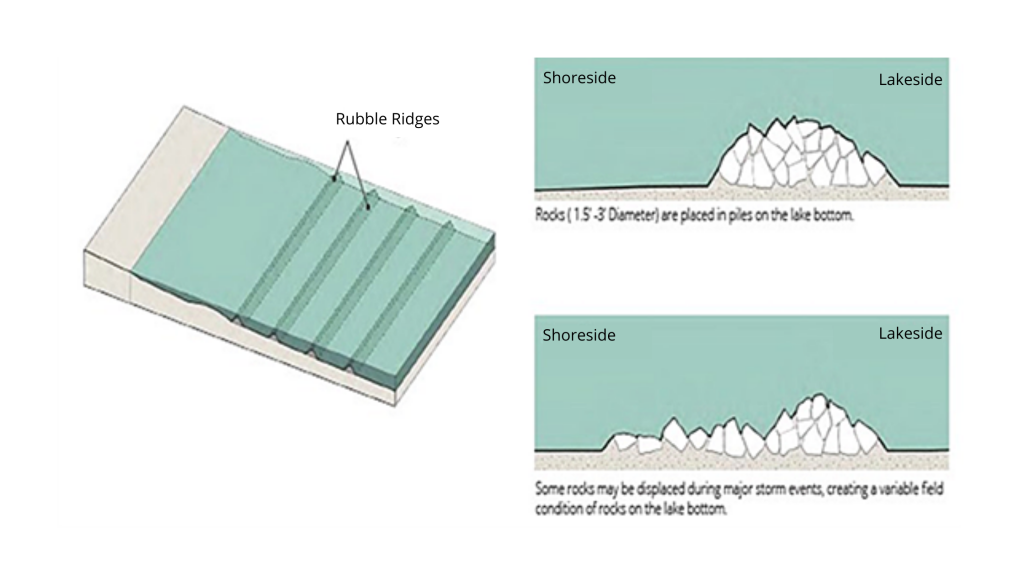
Anchor QEA, as part of the Great Lakes Healthy Port Futures Team, designed and modeled the low-crested offshore reef. The structure is placed as mounds on the lake bottom which may be displaced during major storm events, to create a variable field of rock and rubble ridges, for longer-term protection.
Protecting Ecosystems with Living Shorelines: Little Beaver Island Park Shoreline
The challenge for projects to restore ecosystem functionality is to modify the site to ensure conditions are suitable for shoreline habitat. The historically protected Little Beaver Island Park was held together by small rock walls. The Little Beaver Island Shoreline, near the Niagara River and Lake Erie, had been slowly eroding for years, and park functionality and connectivity to the water were critical factors in the new park design. Prioritizing the shoreline ecosystem and habitat, while also keeping the park open to be enjoyed by the community, was also a challenge.
Our team installed a living shoreline with a variety of features, including a replanted upper bank, a rock barrier to stabilize and protect the shore from high wave energy, and woody debris behind a barrier reef to provide variation for different species. This design created a slope that provided a welcoming nearshore habitat, gradual conductivity to the water, and a sanctuary for fish. Such configurations can often improve water quality, offer protection from future erosion, and help prevent future damage to coastal ecosystems.
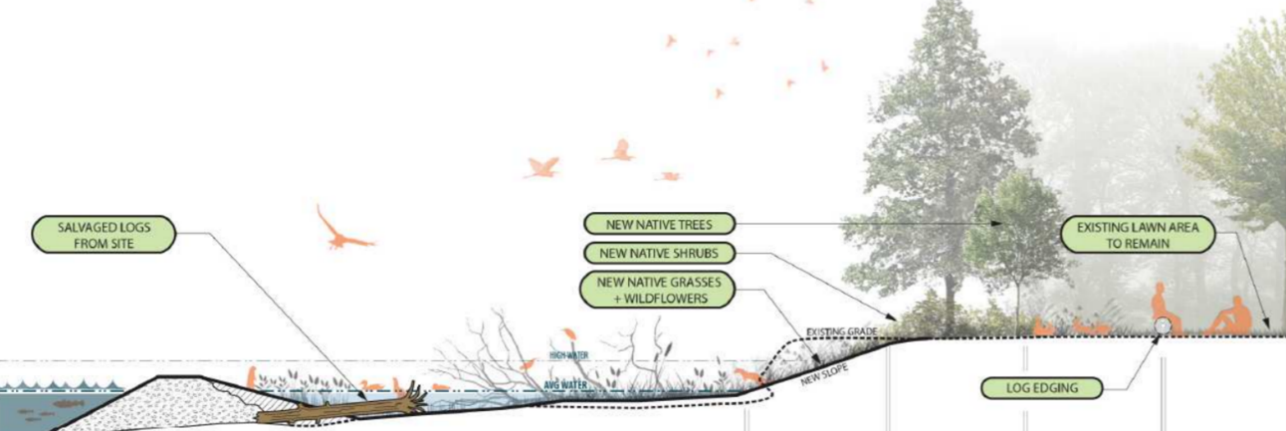
This innovative living shoreline design for the park included a new barrier rock reef, wetland and nearshore habitat, the gentle slope to create gradual conductivity, and new meadow with native vegetation including grasses, shrubs and trees.
Incorporating Natural Solutions to Achieve Long Term Resiliency
The spectrum of methods to promote coastal resiliency includes creating living shorelines and restoring dune, beach, and marsh systems. Each solution anticipates and prepares for future hazardous events to make shorelines resilient in the long term. All these natural infrastructure techniques ultimately protect habitat by reducing shoreline erosion, buffering the effects of water rise, and even connecting diverse animal habitats. Nature-based structures are typically used in lower wave energy environments, and harder structures are typically used in areas of higher wave energy and erosional forces. Often, the best approach to improve coastal resiliency is to combine both types of methods.
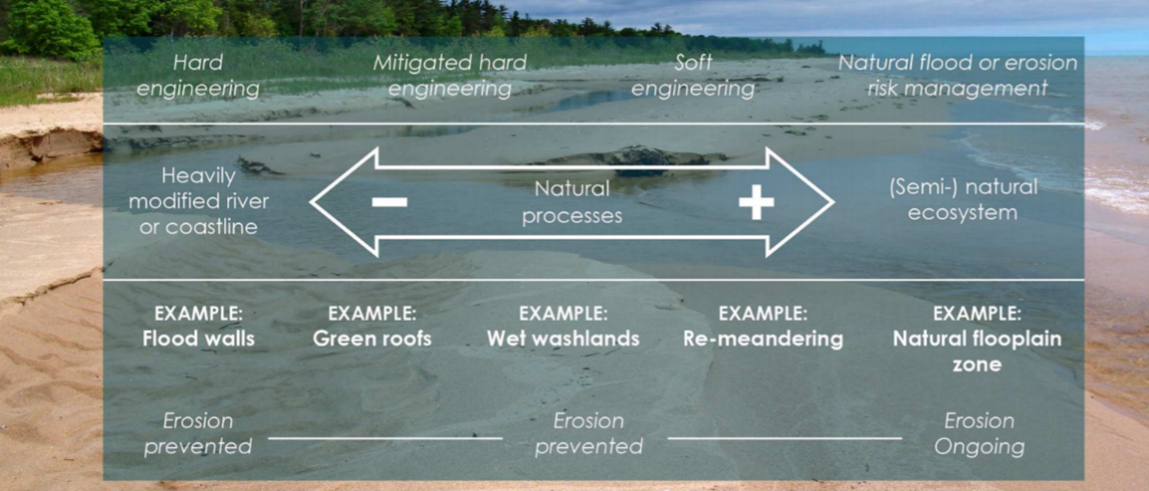
The spectrum of coastal resiliency solutions ranges from harder structures such as flood walls and green roofs to softer, nature-based solutions such as natural floodplain zones (Image courtesy of NNBF Guidance by USACE ERDC).
Understanding and measuring a community’s ability to absorb or withstand an event, in addition to assessing how quickly the natural resources recover from such impacts, is often the first step to finding the right resiliency solution. Every ecosystem is unique and must be monitored to gain a better understanding of how the community can be better prepared. Once the existing conditions are understood, a variety of factors and approaches can be evaluated to help make decisions about how to protect habitat.
Habitat restoration along the Great Lakes shorelines is critical, and sustainable management approaches designed to protect these areas will make shorelines resilient to extreme water levels and erosion for decades to come. Ultimately, coastal resiliency techniques that are designed with the natural system in mind and that support coastal processes will provide long-term protection, enhance the local ecosystem, and yield many benefits to communities.

